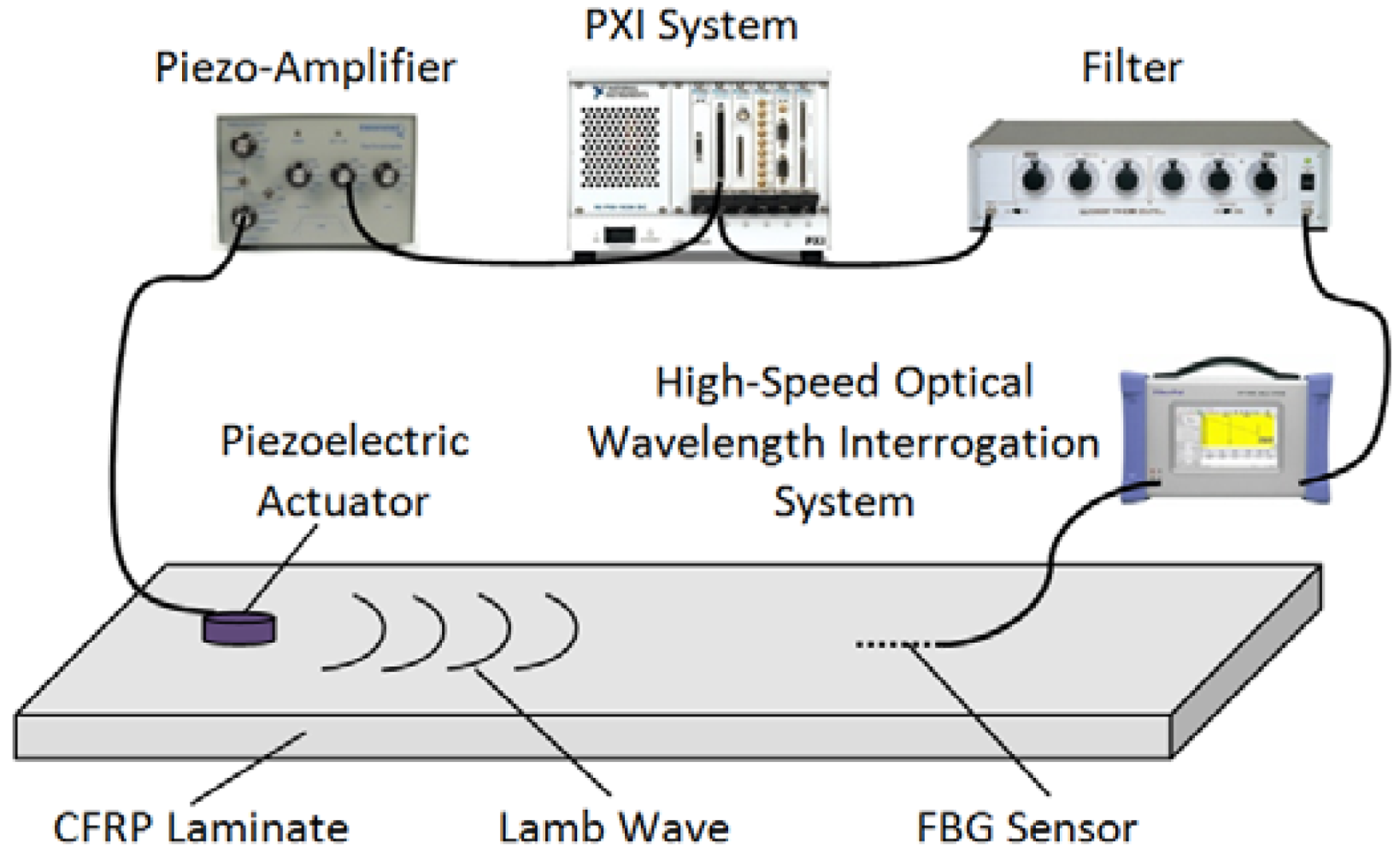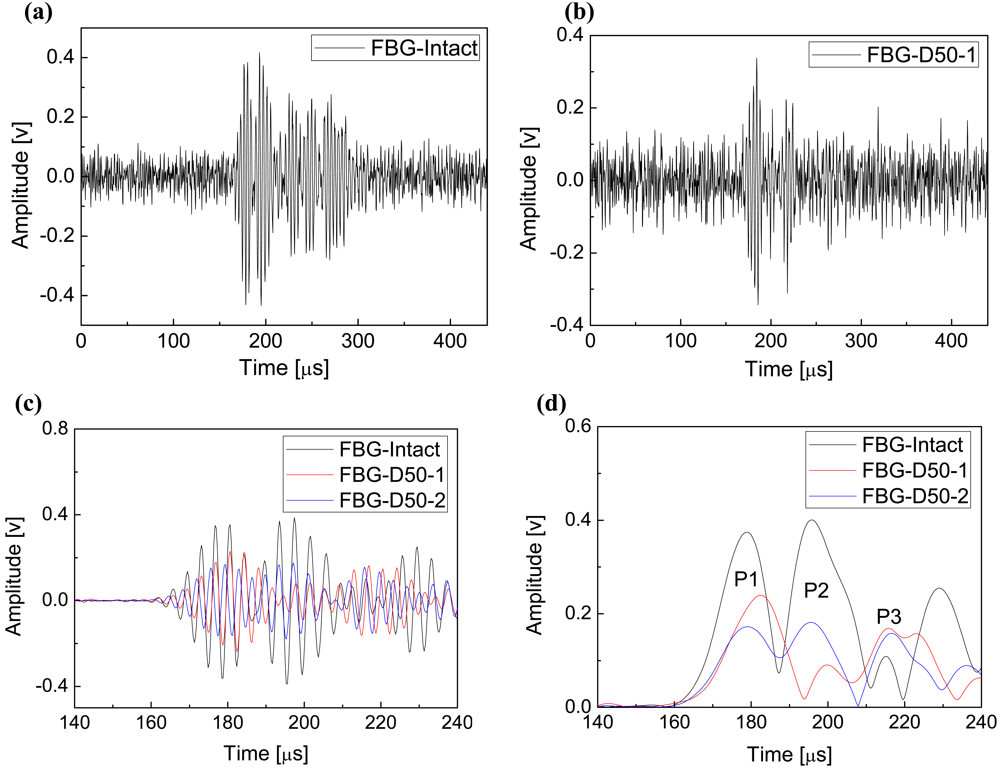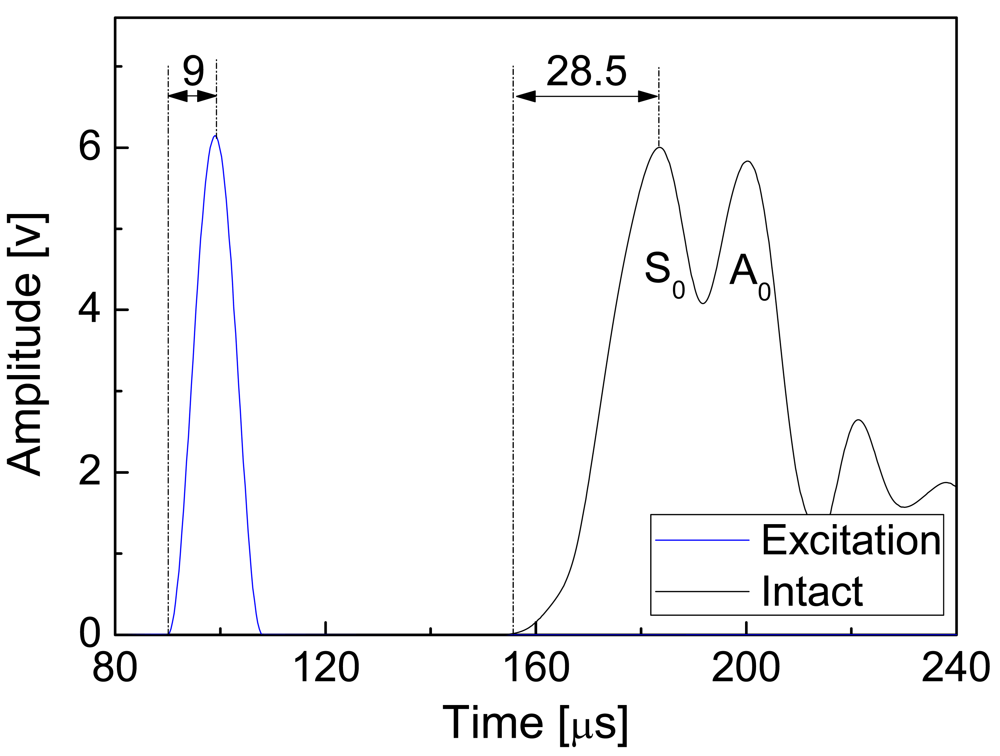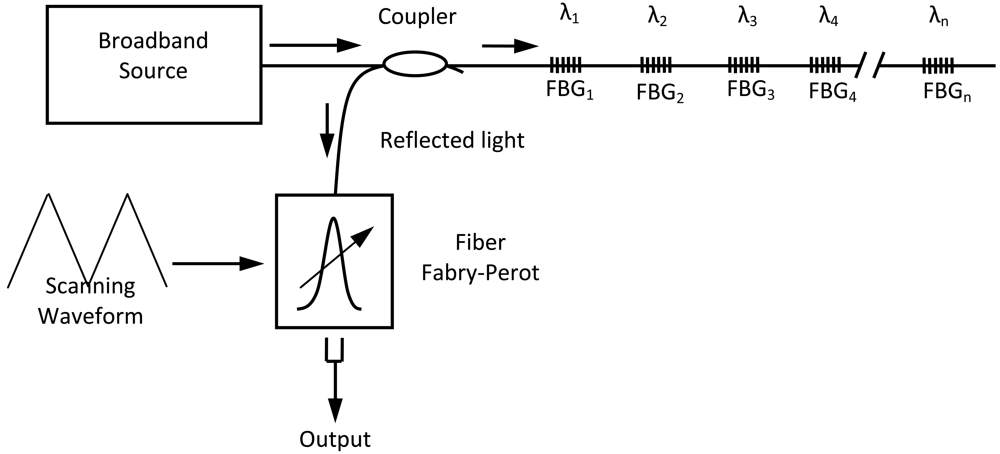Guided Wave and Damage Detection in Composite Laminates Using Different Fiber Optic Sensors
Abstract
:1. Introduction
2. Guided Wave Detection Using Fiber optic Sensors
2.1. Guided Wave Detection Using Fiber Bragg Gratings (FBGs)
2.2. Guided Wave Detection Using FOD sensor
3. Guided Wave and Damage Detection in CFRP Laminates
3.1. CFRP Laminates
3.2. Fiber optic Sensors-Based Damage Detection
3.2.1. Damage Detection Using FBG-Based Guided Signals
3.2.2. Damage Detection Using FOD-Based Guided Signals
3.2.3. Multiple Damage Detection Using FOD-Based Guided Signals
3.3. Discussions
4. Conclusions
Acknowledgments
References and Notes
- Alleyne, D.N.; Cawley, P. The interaction of lamb waves with defects. IEEE T. Ultrason. Ferroelectr. 1992, 39, 381–397. [Google Scholar]
- Zhao, X.L.; Rose, J.L. Boundary element modeling for defect characterization potential in a wave guide. Int. J. Solids Struct. 2003, 40, 2645–2658. [Google Scholar]
- Rose, J.L. Ultrasonic Waves in Solid Media; Cambridge University Press: Cambridge, UK, 1999. [Google Scholar]
- Alleyne, D.N.; Cawley, P. Long range propagation of lamb waves in chemical plant pipework. Mater. Eval. 1997, 55, 504–508. [Google Scholar]
- Takeda, N.; Okabe, Y.; Kuwahara, J.; Kojima, S.; Ogisu, T. Development of smart composite structures with small-diameter fiber Bragg grating sensors for damage detection: Quantitative evaluation of delamination length in CFRP laminates using Lamb wave sensing. Compos. Sci. Technol. 2005, 65, 2575–2587. [Google Scholar]
- Giurgiutiu, V. Tuned lamb wave excitation and detection with piezoelectric wafer active sensors for structural health monitoring. J. Intel. Mat. Syst. Struct. 2005, 16, 291–305. [Google Scholar]
- Fomitchov, P.A.; Krishnaswamy, S.; Achenbach, J.D. Extrinsic and intrinsic fiber optic Sagnac ultrasound sensors. Opt. Eng. 2000, 39, 1972–1984. [Google Scholar]
- Kim, Y.; Ha, S.; Chang, F.K. Time-domain spectral element method for built-in piezoelectric-actuator-induced lamb wave propagation analysis. AIAA J. 2008, 46, 591–600. [Google Scholar]
- Yu, L; Giurgiutiu, V. In situ 2-D piezoelectric wafer active sensors arrays for guided wave damage detection. Ultrasonics 2008, 48, 117–134. [Google Scholar]
- Lee, B.C.; Manson, G.; Staszewski, W.J. Environmental effects on lamb wave responses from piezoceramic sensors. Mod. Pract. Stress Vibr. Anal. 2003, 440-4, 195–202. [Google Scholar]
- Tsuda, H. Ultrasound and damage detection in CFRP using fiber Bragg grating sensors. Compos. Sci. Technol. 2006, 66, 676–683. [Google Scholar]
- Kageyama, K.; Murayama, H.; Uzawa, K.; Ohsawa, I.; Kanai, M.; Akematsu, Y.; Nagata, K.; Ogawa, T. Doppler effect in flexible and expandable light waveguide and development of new fiber-optic vibration/acoustic sensor. J. Lightwave Technol. 2006, 24, 1768–1775. [Google Scholar]
- Alcoz, J.J.; Lee, C.E.; Taylor, H.F. Embedded fiber-optic Fabry-Perot Ultrasound sensor. IEEE T. Ultrason. Ferroelectr. 1990, 37, 302–306. [Google Scholar]
- Dorighi, J.F.; Krishnaswamy, S.; Achenbach, J.D. Stabilization of an embedded fiber-optic Fabry-Perot sensor for ultrasound detection. IEEE T. Ultrason. Ferroelectr. 1995, 42, 820–824. [Google Scholar]
- Tsuda, H.; Lee, J.R.; Guan, Y.S.; Takatsubo, J. Investigation of fatigue crack in stainless steel using a mobile fiber Brago, grating ultrasonic sensor. Opt. Fiber Technol. 2007, 13, 209–214. [Google Scholar]
- Yashiro, S.; Okabe, T.; Takeda, N. Damage identification in a holed CFRP laminate using a chirped fiber Bragg grating sensor. Compos. Sci. Technol. 2007, 67, 286–295. [Google Scholar]
- Tsuda, H.; Lee, J.R.; Guan, Y.S. Fatigue crack propagation monitoring of stainless steel using fiber Bragg grating ultrasound sensors. Smart Mater. Struct. 2006, 15, 1429–1437. [Google Scholar]
- Betz, D.C.; Thursby, G.; Culshaw, B.; Staszewski, W.J. Advanced layout of a fiber Bragg grating strain gauge rosette. J. Lightwave Technol. 2006, 24, 1019–1026. [Google Scholar]
- Park, H.J.; Song, M.H. Linear FBG temperature sensor interrogation with fabry-perot ITU multi-wavelength reference. Sensors 2008, 8, 6769–6776. [Google Scholar]
- Betz, D.C.; Thursby, G.; Culshaw, B.; Staszewski, W.J. Acousto-ultrasonic sensing using fiber Bragg gratings. Smart Mater. Struct. 2003, 12, 122–128. [Google Scholar]
- Fomitchov, P.; Krishnaswamy, S. Response of a fiber Bragg grating ultrasonic sensor. Opt. Eng. 2003, 42, 956–963. [Google Scholar]
- Li, F.C.; Murayama, H.; Kageyama, K.; Shirai, T. Doppler effect-based fiber-optic sensor and its application in ultrasonic detection. Opt. Fiber Technol. 2009, 15, 296–303. [Google Scholar]
- Su, Z.Q.; Wang, X.M.; Chen, Z.P.; Ye, L.; Wang, D. A built-in active sensor network for health monitoring of composite structures. Smart Mater. Struct. 2006, 15, 1939–1949. [Google Scholar]
- Su, Z.Q.; Yang, C.H.; Pan, N.; Ye, L.; Zhou, L.M. Assessment of delamination in composite beams using shear horizontal (SH) wave mode. Compos. Sci. Technol. 2007, 67, 244–251. [Google Scholar]
- Lu, Y.; Ye, L.; Su, Z.Q. Crack identification in aluminium plates using Lamb wave signals of a PZT sensor network. Smart Mater. Struct. 2006, 15, 839–849. [Google Scholar]
- Yuan, W.C.; Zhou, L.; Yuan, F.G. Wave reflection and transmission in composite beams containing semi-infinite delamination. J. Sound Vib. 2008, 313, 676–695. [Google Scholar]
- Guo, N.; Cawley, P. The interaction of Lamb waves with delaminations in composite laminates. J. Acoust. Soc. Am. 1993, 94, 2240–2246. [Google Scholar]
- Sekhar, A.S. Multiple cracks effects and identification. Mech. Syst. Signal Pr. 2008, 22, 845–878. [Google Scholar]
- Lin, X.; Yuan, F.G. Detection of multiple damages by prestack reverse-time migration. AIAA J. 2001, 39, 2206–2215. [Google Scholar]
- Gangadharan, R.; Mahapatra, D.R.; Gopalakrishnan, S.; Murthy, C.R.L.; Bhat, M.R. On the sensitivity of elastic waves due to structural damages: Time-frequency based indexing method. J. Sound Vib. 2009, 320, 915–941. [Google Scholar]
- Yu, L.Y.; Giurgiutiu, V. In-situ optimized PWAS phased arrays for lamb wave structural health monitoring. J. Mech. Mater. Struct. 2007, 2, 459–487. [Google Scholar]
- Lu, Y.; Ye, L.; Su, Z.Q.; Yang, C.H. Quantitative assessment of through-thickness crack size based on Lamb wave scattering in aluminium plates. NDT E Int. 2008, 41, 59–68. [Google Scholar]
- Mathworks. Wavelet Toolbox: for Use with Matlab (User's Guide); Mathworks Inc.: Sherborn, MA, USA, 2008. [Google Scholar]
- Feldman, M. Theoretical analysis and comparison of the Hilbert transform decomposition methods. Mech. Syst. Signal Pr. 2008, 22, 509–519. [Google Scholar]
- Kessler, S.S.; Spearing, S.M.; Soutis, C. Damage detection in composite materials using Lamb wave methods. Smart Mater. Struct. 2002, 11, 269–278. [Google Scholar]
- Voyiadjis, G.Z.; Kattan, P.I. Mech. Compos. Mater. MATLAB; Springer: Dordrecht, The Netherlands, 2005. [Google Scholar]
- Wang, L.; Yuan, F.G. Group velocity and characteristic wave curves of Lamb waves in composites: Modeling and experiments. Compos. Sci. Technol. 2007, 67, 1370–1384. [Google Scholar]
- Grattan, K.T.V.; Sun, T. Fiber optic sensor technology: introduction and overview. In Optical Fiber Sensor Technology-Fundamentals; Grattan, K.T.V., Meggitt, B.T., Eds.; Kluwer Academic Publishers: Dordrecht, The Netherlands, 2000; pp. 1–44. [Google Scholar]











| (a) Technical parameters of the carbon fiber (TR30S) | |||||||||
|---|---|---|---|---|---|---|---|---|---|
| Product name | Ingredient | Modulus [GPa] | Possion's ratio [g/m] | Density [g/m3] | |||||
| TR30S | Carbon fiber | 235 | 0.2 | 1770 | |||||
| Epoxy resin | 3.23 | 0.34 | 1250 | ||||||
| (b) Elastic properties for individual lamina | |||||||||
| E11 [GPa] | E22 [GPa] | E33 [GPa] | G12 [GPa] | G13 [GPa] | G23 [GPa] | ν12 | ν13 | ν23 | Density [g/m3] |
| 140 | 9.07 | 9.07 | 4.25 | 4.25 | 2.94 | 0.258 | 0.258 | 0.39 | 1560 |
| Fiber optic Sensor | Signal-to-Noise Ratio (SNR) | ||
|---|---|---|---|
| Original Signal | Average of 10 Original Signals | Average of 60 Original Signals | |
| FBG-Sensor | 26.36 | 36.30 | 43.68 |
| FOD-Sensor | 52.60 | 61.72 | -------- |
© 2009 by the authors; licensee Molecular Diversity Preservation International, Basel, Switzerland. This article is an open access article distributed under the terms and conditions of the Creative Commons Attribution license (http://creativecommons.org/licenses/by/3.0/).
Share and Cite
Li, F.; Murayama, H.; Kageyama, K.; Shirai, T. Guided Wave and Damage Detection in Composite Laminates Using Different Fiber Optic Sensors. Sensors 2009, 9, 4005-4021. https://doi.org/10.3390/s90504005
Li F, Murayama H, Kageyama K, Shirai T. Guided Wave and Damage Detection in Composite Laminates Using Different Fiber Optic Sensors. Sensors. 2009; 9(5):4005-4021. https://doi.org/10.3390/s90504005
Chicago/Turabian StyleLi, Fucai, Hideaki Murayama, Kazuro Kageyama, and Takehiro Shirai. 2009. "Guided Wave and Damage Detection in Composite Laminates Using Different Fiber Optic Sensors" Sensors 9, no. 5: 4005-4021. https://doi.org/10.3390/s90504005




